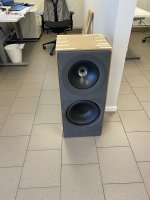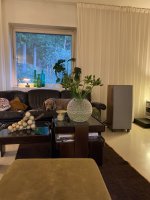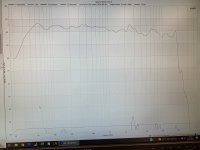We all make mistakes some time, at least it was one in the digital domain which is a simple enough fix 🙂I forgot to apply mic calibration for my dayton EMM-6 mic using which i took the measurements for the sica coax mid and tweeter.
The basic idea is there, if not quite as refined, hard to know how much difference it will make.I think there is still room for improvement on this one compared to the crossover that fluid designed earlier.
I will work on it and also try to adapt the latest crossover that fluid posted above.
One quick thing you can do to test the original crossover settings is to apply the mic correction response as an inverse filter as global EQ. REW has the function to make an impulse from a frequency response now I think which would make it easy.
Your thoughts make sense, the waveguide you have is really quite directive and the presentation will be much different to the coax in terms of the direct to reflected sound ratio. Your room looks to be untreated with a lot of reflective and hard surfaces. The sound being very similar throughout the room with the coax also makes sense as the vertical directivity is pretty broad and similar to the horizontal.Next I am attempting to describe about what i heard with this crossover sitting about 2.5m away from the speaker on axis with the coax tweeter.
The very high treble being more present on the coax is as expected, the 1" dome with the mid as waveguide is wider and the 1.4" CD on a tractrix'ish waveguide is narrow and in breakup.
The HF dip is more of an on axis or near axis issue, off axis it is less pronounced, the horizontal curves in post 601 above show it. This is an acoustic cancellation most likely from the small lip on the tweeter. I think any attempt to equalize it would fail which is why I left it alone.Do you have any suggestion on how I can test it..?
Using sine sweeps first and seeing if there is any relative amplitude difference noticeable with that dip vs without that dip?
I have noticed subtle differences with changes in very high frequency EQ but I doubt it would be easy to hear much difference with sine tones at that frequency unless you get some children to do the testing.
I completely agree with fluid on the issue of being wary of placing too much weight on the on-axis response of coaxes. They pretty much universally are better off listened to and optimized off axis. This has been pointed out to me in conversations with BMS and Seas designers after many fruitless attempts by me in ‘fixing’ these effects with DSP.
Learned the hard way that it’s much better to look at the trend of the horizontals as fluid is pointing out than focusing on a pretty straight line on axis. The on axis response is really like looking at the landscape through a straw.
Learned the hard way that it’s much better to look at the trend of the horizontals as fluid is pointing out than focusing on a pretty straight line on axis. The on axis response is really like looking at the landscape through a straw.
I mean sure, if there are funky things going on you do need to think about the next best thing, like optimising for the listening window or power response for predicted in room response.
Sometime we avoid asking the difficult questions because we don't want to hear the answer.
Like- is it because they can't solve it, that it can't be done?
As in, can one have a coaxial with a flat and smooth on axis AND off axis. For both for the midrange AND the tweeter? Who makes one?
Sometime we avoid asking the difficult questions because we don't want to hear the answer.
Like- is it because they can't solve it, that it can't be done?
As in, can one have a coaxial with a flat and smooth on axis AND off axis. For both for the midrange AND the tweeter? Who makes one?
KEF and Genelec have succeeded, but those drivers are sold only as spare parts via service.
https://www.erinsaudiocorner.com/loudspeakers/kef_r5/
https://www.audiosciencereview.com/...s/genelec-8361a-review-powered-monitor.28039/
https://www.erinsaudiocorner.com/loudspeakers/kef_r5/
https://www.audiosciencereview.com/...s/genelec-8361a-review-powered-monitor.28039/
Don’t know how ‘successful’ this is though. If you take your eyes off of the top line I’d say this still has some issues & right in the most sensitive octaves too boot.
From the bikinipunk👇🏻 test you qouted

From the bikinipunk👇🏻 test you qouted
The Sica on a low diffraction baffle is reasonably well behaved but there is somewhat of a difference between the 0 deg axis and 10 degrees which I used as the reference axis. This is a gif of the difference between changing the reference axis between 0 and 10. No coaxial should be listened to with it pointed straight at you so the 0 degrees is the listening axis. When listened to 10 to 15 degrees off axis (like you get when pointing the speakers straight ahead instead of straight at you) the on axis that you hear is then generally quite flat as you can see in my crossovers.

The listening window is how the speaker should be optimized in almost all cases not the zero degree response as it contains the worst of all diffractions. On axis and 0 degrees are not always the same thing. I think this is one of those times where the words of Floyd Toole are being twisted to mean something different than intended. Smooth flat on axis does not have to mean 0 degree axis.
Kef's Reference 1 Meta is really good as coaxial's go, apart from the 12K dip in the Sica I think Vineeth's stacks up pretty well in comparison, I suspect the Kef would look better if the reference axis was 10 degrees too. I think the Sica design has been made to allow for more excursion in the woofer making it more like the LS50 driver. Kef and Genelec's top coaxials are designed to be low excursion mid tweeter drivers only.

The listening window is how the speaker should be optimized in almost all cases not the zero degree response as it contains the worst of all diffractions. On axis and 0 degrees are not always the same thing. I think this is one of those times where the words of Floyd Toole are being twisted to mean something different than intended. Smooth flat on axis does not have to mean 0 degree axis.
Kef's Reference 1 Meta is really good as coaxial's go, apart from the 12K dip in the Sica I think Vineeth's stacks up pretty well in comparison, I suspect the Kef would look better if the reference axis was 10 degrees too. I think the Sica design has been made to allow for more excursion in the woofer making it more like the LS50 driver. Kef and Genelec's top coaxials are designed to be low excursion mid tweeter drivers only.
As in, can one have a coaxial with a flat and smooth on axis AND off axis. For both for the midrange AND the tweeter? Who makes one?
Does it really matter in the end?
I mean, the on axis anomaly are focused on a small portion of the 3d 'beamwidth' ( for a typical conical dispersion pattern, eg:90*).
In fact past 15* of offset wrt listening 'on-axis' issues almost disapear ( with a low diffraction design at least).
If your room have a bit of depth ( length) and you can diffuse a bit on back wall ( or absorb) then the radiated angular portion of nasty looking 'on axis' measurement can be easily dealt with ( diffusion: less specularity so freq aberation have a chance to be masked and delayed when reaching listening point, distance= lower by 6db each time you bouble distance traveled by wave so less obvious).
As pointed by Fluid it'll make early reflections mostly identical and if smooth power response is achieved it'll give this firm stable soundstage and feeling the sound is the 'same' in the room ( it's not true there is still issues but they have a different presentation than non coax loudspeakers, less obvious with coax).
From there this is a matter of compromise and preference. The room play a huge role in this too.
In my room (5,7m x 6.6m, sloted/cathedral ceiling -lowest side: front wall at 2,1m to 3,8m in the midlle of the room ~30° slope- still untreated, with large reflecting area-including a 90% glass covered front wall, behind loudspeakers) there is no question for mid high, coax win for my pref against 6,5"+1"; typical 80's/90's three way 15"+4,5"+1",
I liked results with a 2way with waveguide too ( comp driver, 60°) but it had a too narrow sweetspot to me.
I missed the 'same sound everywhere' effect. I could have worked on them though.
Airvoid,
The issue you point is imho a design choice: they have to scale up in quality in their range, using the same 'basic' driver design ( they can vary diaphragm material and some 'details' - it's trackable through Kef's whitepapers- but the basic design is the same).
If you look at xover choices between Rseries and Reference and Muon they differ in some case. But use the same 'base' for the driver. Iow with a xover at 2khz the issue you pointed can be mitigated.
Airvoid, you have a BMS coax based loudspeaker atm? Or you used them for live?
Last pic shows early development Klippel FQ at (20 degrees of course😉
BMS 10C262 passive cardoid / 12N630 in aperiodic cab.

BMS 10C262 passive cardoid / 12N630 in aperiodic cab.
Attachments
Last edited:
Nice! 10"?
Lucky you to have access to an anechoic chamber! Where it is located ( if not confidential)?
Lucky you to have access to an anechoic chamber! Where it is located ( if not confidential)?
There’s a giveaway in the pic…Nice! 10"?
Lucky you to have access to an anechoic chamber! Where it is located ( if not confidential)?
Nice setup w B&K mikes, full Klippel w turntable and distortion modules etc (not NFS).
Wow i didn't spoted the clue at first!
You work there?! Now i'm jealous! 😉
I was going to ask about the peaks, the other 10c362 measurements i've seen didn't had them.
How would you describe the forte of your LS ( and bad sides too!)?
You work there?! Now i'm jealous! 😉
I was going to ask about the peaks, the other 10c362 measurements i've seen didn't had them.
How would you describe the forte of your LS ( and bad sides too!)?
There’s a giveaway in the pic…
No, just squeezed my way in there.Wow i didn't spoted the clue at first!
You work there?! Now i'm jealous! 😉
I was going to ask about the peaks, the other 10c362 measurements i've seen didn't had them.
How would you describe the forte of your LS ( and bad sides too!)?
I don’t want to steal the thread from vineeth so I’ll just say they are very dynamic and image extremely well. There’s a special magic to a well executed coax, just fills the room with music.
I agree.
I had to choose between Kef and BMS, choosen the first because BMS seemed to have too long delay and Kef seemed availlable...and i'm waiting for drivers for 3month, delivery delayed again early september and BMS are back in stock!
Anyway the dynamic this 10" and 12" have is the big compromise i think i've made with the Kef.
I'll see if driven by the amp i choose it'll not be missing to much.
It leave door open to something else ( another design) with a BMS which is... inspiring.
Maybe they'll release the lower power version of 12C382 and 10c362 they announced when it'll itch me too much.
Airvoid did you document your built somewhere?
I had to choose between Kef and BMS, choosen the first because BMS seemed to have too long delay and Kef seemed availlable...and i'm waiting for drivers for 3month, delivery delayed again early september and BMS are back in stock!
Anyway the dynamic this 10" and 12" have is the big compromise i think i've made with the Kef.
I'll see if driven by the amp i choose it'll not be missing to much.
It leave door open to something else ( another design) with a BMS which is... inspiring.
Maybe they'll release the lower power version of 12C382 and 10c362 they announced when it'll itch me too much.
Airvoid did you document your built somewhere?
I had no idea they had those planned. No official documentation, they are ending up as a commercial project.I agree.
I had to choose between Kef and BMS, choosen the first because BMS seemed to have too long delay and Kef seemed availlable...and i'm waiting for drivers for 3month, delivery delayed again early september and BMS are back in stock!
Anyway the dynamic this 10" and 12" have is the big compromise i think i've made with the Kef.
I'll see if driven by the amp i choose it'll not be missing to much.
It leave door open to something else ( another design) with a BMS which is... inspiring.
Maybe they'll release the lower power version of 12C382 and 10c362 they announced when it'll itch me too much.
Airvoid did you document your built somewhere?
I'll have to find where it does come from but yes two variation was planed, lower power and higher power around same driver base.
I think the 12c381 was mentioned as lower power variant, but maybe i've had hallucination.
Will check.
I think the 12c381 was mentioned as lower power variant, but maybe i've had hallucination.
Will check.
I see these Sica coaxes as well.
https://en.toutlehautparleur.com/coaxial-speaker-sica-6cx2plp-8-8-ohm-6-inch.html
Are they any better? What kind of applications are these made for?
https://en.toutlehautparleur.com/coaxial-speaker-sica-6cx2plp-8-8-ohm-6-inch.html
Are they any better? What kind of applications are these made for?
It wasn't this far away:
https://audioxpress.com/news/bms-sp...ers-and-next-generation-1-compression-drivers
12c381 et 12c383. That said 2019 seems like a century ago from where i stand. Maybe this is postponed or dead. Too bad if it's dead. But i hope they'll keep 12c382 availlable.
Vineeth, if after playing with other acoustic design you come back to coax try bigger diameter. 10"/12"/15" from serious PA ( Faital, Bms, Beyma, B&C,..). There is something to them...about the dynamic.
https://audioxpress.com/news/bms-sp...ers-and-next-generation-1-compression-drivers
12c381 et 12c383. That said 2019 seems like a century ago from where i stand. Maybe this is postponed or dead. Too bad if it's dead. But i hope they'll keep 12c382 availlable.
Vineeth, if after playing with other acoustic design you come back to coax try bigger diameter. 10"/12"/15" from serious PA ( Faital, Bms, Beyma, B&C,..). There is something to them...about the dynamic.
Last edited:
- Home
- Loudspeakers
- Multi-Way
- A 3 way design study


